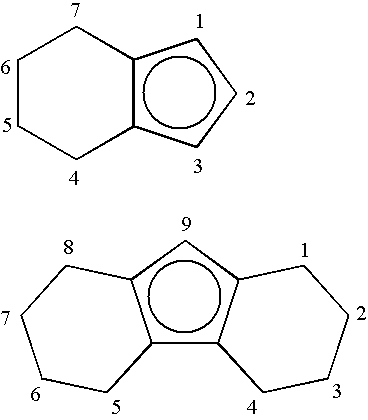Catalyst for olefin/styrene copolymerization, and process for producing olefin/styrene copolymer
a technology of olefin and styrene, which is applied in the direction of catalyst activation/preparation, organic compound/hydride/coordination complex catalyst, physical/chemical process catalyst, etc., can solve the problem of unfavorable coloring of polymers, unsatisfactory catalyst activity, and high cost of total catalys
- Summary
- Abstract
- Description
- Claims
- Application Information
AI Technical Summary
Benefits of technology
Problems solved by technology
Method used
Image
Examples
example 1
(1) Preparation of Component (C):
0.875 ml of 2 M triisobutylaluminium was added to a toluene solution of 455 mg (1.75 mmols) of triphenylmethanol at −78° C., and stirred at room temperature for 24 hours. The concentration of the component (C) thus formed was 0.1 mols / liter.
Through 1H-NMR, the product was confirmed to have the component (C) formed therein.
(2) Preparation of Copolymer:
180 ml of toluene, 200 ml of styrene, 1.0 ml of a toluene solution of 1.0 M triisobutylaluminium, 3.5 ml of a toluene solution of 1.43 M methylaluminoxane, and 5 ml of the component (C) prepared in the step (1) were put into a 1.6-liter autoclave equipped with a catalyst feeder tube, in that order, and heated up to 50° C. Next, ethylene was introduced into the autoclave to have a pressure of 0.294 MPaG (3 kg / cm2G). Next, 10.0 μmol of (t-butylamido)dimethyl(tetramethyl-η5-cyclopentadienyl)silane-titanium dichloride dissolved in 20 ml of toluene was put into the autoclave via the catalyst feeder tube. Ethy...
example 2
170 ml of toluene, 200 ml of styrene, 1.0 ml of a toluene solution of 1.0 M triisobutylaluminium, and 5.0 ml of a ethylbenzene solution of 0.1 M diisobutyl-aluminiumtriphenyl methoxide were put into a 1.6-liter autoclave equipped with a catalyst feeder tube, in that order, and heated up to 50° C. Next, ethylene was introduced into the autoclave to have a pressure of 0.294 MPaG (3 kg / cm2G). Next, a soliution where 10.0 μmol of octahydrofluorenyl-titanium trimethoxide and 10 mmol of methylaluminoxane dissolved in 25 ml of toluene was put into the autoclave via the catalyst feeder tube. Ethylene was continuously introduced into the autoclave so as to have all the time the constant pressure of 3.0 kg / cm2G (0.294 MpaG), and copolymerized for 1 hour. Next, methanol was added to this to stop the copolymerization. A large amount of methanol was added to this, and the polymer formed was separated through filtration, and then dried at 60° C. under reduced pressure for 4 hours. Thus obtained, ...
example 3
165 ml of toluene, 200 ml of styrene, 1.0 ml of a toluene solution of 1.0 M triisobutylaluminium, and 5.0 ml of a ethylbenzene solution of 0.1 M diisobutyl-aluminium triphenyl methoxide were put into a 1.6-liter autoclave equipped with a catalyst feeder tube, in that order, and heated up to 50° C. Next, ethylene was introduced into the autoclave to have a pressure of 0.294 MPaG (3 kg / cm2G). Next, a soliution where 10.0 μmol of N,N-dimethylamino-ethyltetramethyl cyclopentadienyl-titanium dichloride and 10 mmol of methylaluminoxane dissolved in 25 ml of toluene was put into the autoclave via the catalyst feeder tube. Ethylene was continuously introduced into the autoclave so as to have all the time the constant pressure of 3.0 kg cm2G (0.294 MpaG), and copolymerized for 1 hour. Next, methanol was added to this to stop the copolymerization. A large amount of methanol was added to this, and the polymer formed was separated through filtration, and then dried at 60° C. under reduced press...
PUM
 Login to View More
Login to View More Abstract
Description
Claims
Application Information
 Login to View More
Login to View More - R&D
- Intellectual Property
- Life Sciences
- Materials
- Tech Scout
- Unparalleled Data Quality
- Higher Quality Content
- 60% Fewer Hallucinations
Browse by: Latest US Patents, China's latest patents, Technical Efficacy Thesaurus, Application Domain, Technology Topic, Popular Technical Reports.
© 2025 PatSnap. All rights reserved.Legal|Privacy policy|Modern Slavery Act Transparency Statement|Sitemap|About US| Contact US: help@patsnap.com



